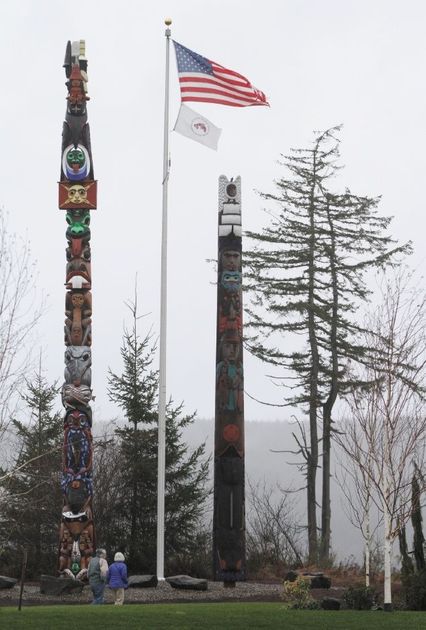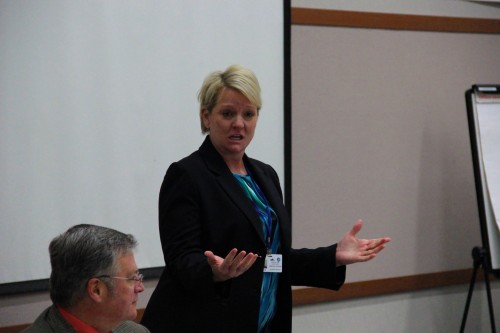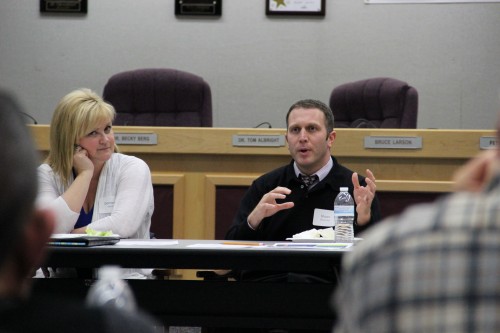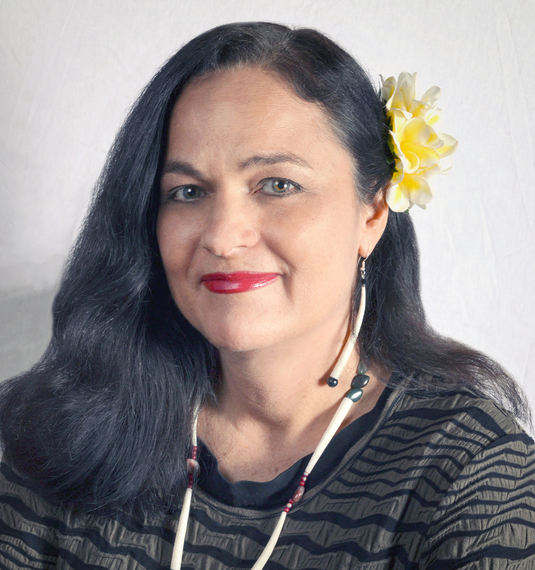By TONY BARBOZA, Los Angeles Times, January 9, 2014
Read more here: http://www.theolympian.com/2014/01/09/2921922/sardine-crash-raising-alarms-experts.html#storylink=cpy
LOS ANGELES — The sardine fishing boat Eileen motored slowly through moonlit waters from San Pedro to Santa Catalina Island, its weary-eyed captain growing more desperate as the night wore on. After 12 hours and $1,000 worth of fuel, Corbin Hanson and his crew returned to port without a single fish.
“Tonight’s pretty reflective of how things have been going,” Hanson said. “Not very well.”
To blame is the biggest sardine crash in generations, which has made schools of the small, silvery fish a rarity on the West Coast. The decline has prompted steep cuts in the amount fishermen are allowed to catch, and scientists say the effects are probably radiating throughout the ecosystem, starving brown pelicans, sea lions and other predators that rely on the oily, energy-rich fish for food.
If sardines don’t recover soon, experts warn, the West Coast’s marine mammals, seabirds and fishermen could suffer for years.
The reason for the drop is unclear. Sardine populations are famously volatile, but the decline is the steepest since the collapse of the sardine fishery in the mid-20th century. And their numbers are projected to keep sliding.
One factor is a naturally occurring climate cycle known as the Pacific Decadal Oscillation, which in recent years has brought cold, nutrient-rich water to the West Coast. While those conditions have brought a boom in some species, such as market squid, they have repelled sardines.
If nature is responsible for the decline, history shows the fish will bounce back when ocean conditions improve. But without a full understanding of the causes, the crash is raising alarm.
An assessment last fall found the population had dropped 72 percent since its last peak in 2006. Spawning has taken a dive too.
In November, federal fishery managers slashed harvest limits by more than two-thirds, but some environmental groups have argued the catch should be halted outright.
“We shouldn’t be harvesting sardines any time the population is this low,” said Geoff Shester, California program director for the conservation group Oceana, which contends that continuing to fish for them could speed their decline and arrest any recovery.
The Pacific sardine is the ocean’s quintessential boom-bust fish. It is short-lived and prolific, and its numbers are wildly unpredictable, surging up and down in decades-long cycles in response to natural shifts in the ocean environment. When conditions are poor, sardine populations plunge. When seas are favorable, they flourish in massive schools.
It was one of those seemingly inexhaustible swells that propelled California’s sardine fishery to a zenith in the 1940s. Aggressive pursuit of the species transformed Monterey into one of the world’s top fishing ports.
And then it collapsed.
By mid-century sardines had practically vanished, and in the 1960s California established a moratorium on sardine fishing that lasted 18 years. The population rebounded in the 1980s and fishing resumed, but never at the level of its heyday.
Since the 1940s scientists have debated how much of the collapse was caused by ocean conditions and how much by overfishing. Now, researchers are posing the same question.
“It’s a terribly difficult scientific problem,” said Russ Vetter, director of the Fisheries Resources Division at NOAA’s Southwest Fisheries Science Center.
Separate sardine populations off Japan, Peru and Chile fluctuate in the same 50- to 70-year climate cycle but have been more heavily exploited, Vetter said. West Coast sardines are considered one of the most cautiously fished stocks in the world, a practice that could explain why their latest rebound lasted as long as it did. The West Coast’s last sardine decline began in 1999, but the population shot back up by the mid-2000s.
In recent years scientists have gained a deeper understanding of sardines’ value as “forage fish,” small but nutrition-packed species such as herring and market squid that form the core of the ocean food web, funneling energy upward by eating tiny plankton and being preyed on by big fish, seabirds, seals and whales.
Now, they say, there is evidence some ocean predators are starving without sardines. Scarcity of prey is the leading theory behind the 1,600 malnourished sea lion pups that washed up along beaches from Santa Barbara to San Diego in early 2013, said Sharon Melin, a wildlife biologist at the National Marine Fisheries Service.
Melin’s research indicates that nursing sea lion mothers could not find fatty sardines, so they fed on less nutritious market squid, rockfish and hake and produced less milk for their young in 2012. The following year their pups showed up on the coast in overwhelming numbers, stranded and emaciated.
“We are likely to see more local events like this if sardines disappear or redistribute along the coast and into deeper water,” said Selina Heppell, a fisheries ecologist at Oregon State University.
Biologists also suspect the drop is hurting brown pelicans that breed on California’s northern Channel Islands. The seabirds, which scoop up sardines close to the ocean surface, have shown signs of starvation and have largely failed to breed or rear chicks there since 2010.
Brown pelicans were listed as endangered in 1970 after they were pushed nearly to extinction by DDT, which thinned their eggshells. They were taken off the list in 2009 and now number about 150,000 along the West Coast.
Though pelicans have had more success recently in Mexico, where about 90 percent of the population breeds, environmental groups think the lack of food at the northern end of their range could threaten the species’ recovery.
Normally, pelicans and sea lions would adapt by instead gobbling up anchovies. But aside from an unusual boom in Monterey Bay, anchovy numbers are depressed too.
“That does not bode well for everything in the ocean that relies on sardines to get big and fat and healthy,” said Steve Marx, policy analyst for the Pew Charitable Trusts, a nonprofit that advocates for ecosystem-based management of fisheries.
Fishermen also attest to the scarcity.
The West Coast sardine catch oscillates with the market and was valued at $14.5 million in 2013, according to the National Marine Fisheries Service. But California fishermen pulled in just $1.5 million worth of sardines last year, preliminary data from state Department of Fish and Wildlife show.
Just a few years ago, Hanson, the sardine captain, didn’t have to travel far from port to pull in nets bulging with sardines.
Not anymore. If his crew catches sardines these days, they are larger, older fish that are mostly shipped overseas and ground up for pet or fish food. Largely absent are the small and valuable young fish that can be sold for bait or canned and eaten.
Still, when he embarked for Catalina Island on a December evening, Hanson tried to stay optimistic. “We’re going to get a lot of fish tonight,” he told a fellow sardine boat over the radio.
After hours of cruising the island’s shallow waters, the voice of another boat captain lamented over the radio, “I haven’t seen a scratch.”
So the Eileen and other boats made an about-face for the Orange County coast, hoping to net sardines in their usual hideouts.
No such luck.
By daybreak, Hanson was piloting the hulking boat back to the docks with nothing in its holds.
Read more here: http://www.theolympian.com/2014/01/09/2921922/sardine-crash-raising-alarms-experts.html#storylink=cpy


















 “Our grants go towards helping artists address issues such as cultural equity, land and water rights, food sovereignty, and Native knowledge,” she said. NACF artists received a Bessie Award for Outstanding Dance Production, had an exhibit at the 18th Biennale of Sydney, Australia, and are taking their film to the national festival circuit and PBS. “This kind of recognition inspires others to help keep the arts alive through their own artistic endeavors — or through their financial support,” she added.
“Our grants go towards helping artists address issues such as cultural equity, land and water rights, food sovereignty, and Native knowledge,” she said. NACF artists received a Bessie Award for Outstanding Dance Production, had an exhibit at the 18th Biennale of Sydney, Australia, and are taking their film to the national festival circuit and PBS. “This kind of recognition inspires others to help keep the arts alive through their own artistic endeavors — or through their financial support,” she added.